Vietnamese food wouldn’t be the same without its jungle of fresh herbs. From Phở to Bánh xèo, they add flavor, fragrance, and crunch—here’s your easy guide to 30 must-know herbs (Rau Thơm) and how to use them.

Most of the photos here are thanks to my amazing mom – a true gardening and home-cooking queen. Finding all these herbs in Germany isn’t always easy, so my mom in Vietnam is my behind-the-scenes superhero.
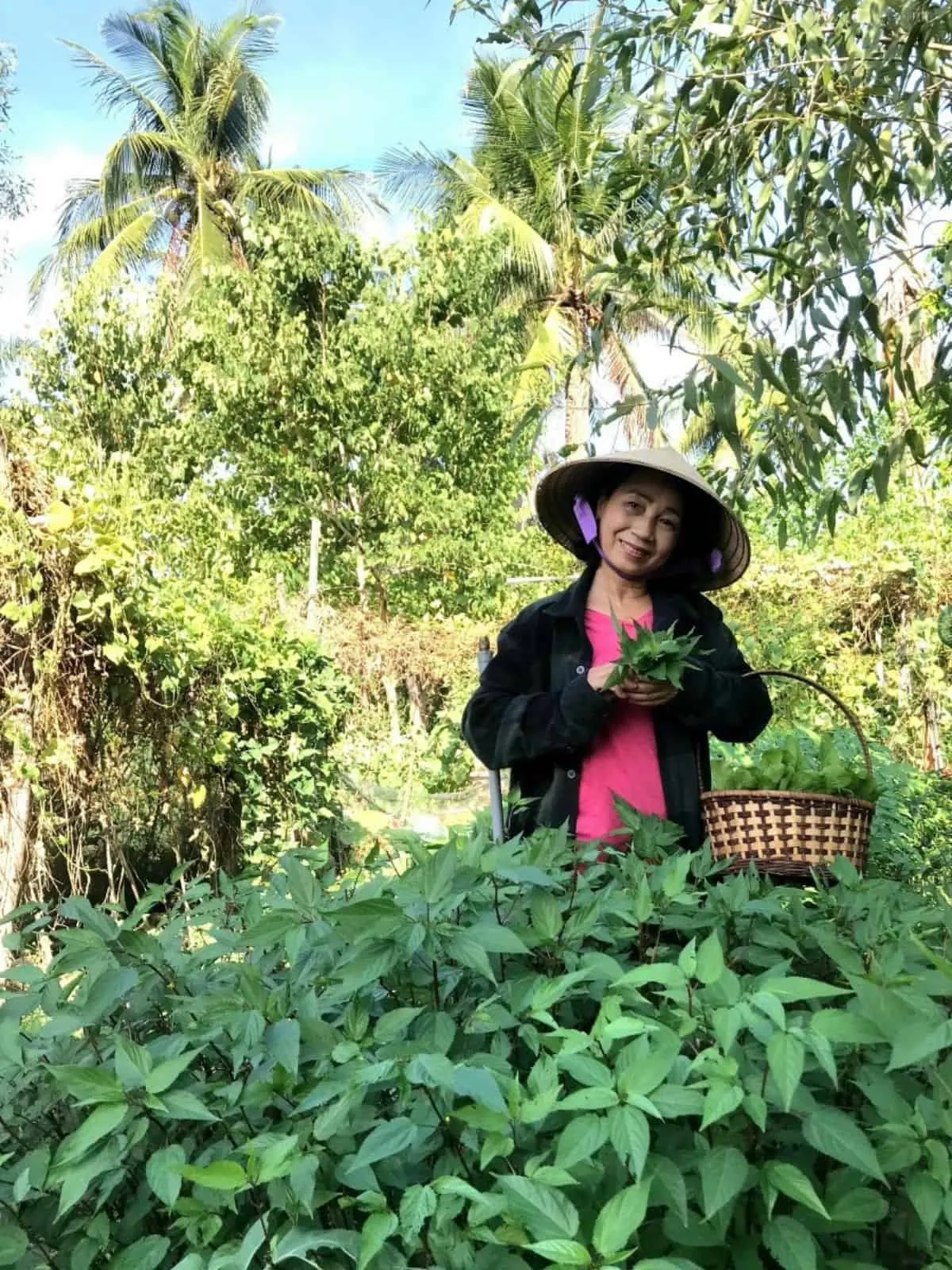
Back then, before “modern medicine” reached Vietnam, fresh herbs were our everyday cure—for colds, stomachaches, or just a bit of indigestion.
We brewed them into teas or tucked them into healing dishes like Cháo Gà (Chicken Congee), the ultimate feel-better food.
- 1. Hành Lá (Green Onion / Scallion)
- 2. Ngò Rí (Cilantro / Coriander)
- 3. Hẹ (Garlic Chives)
- 4. Thì Là (Dill)
- 5. Ngò Gai (Culantro / Sawtooth Herb)
- 6. Ngò Om (Rice Paddy Herb)
- 7. Tía Tô (Perilla Leaves)
- 8. Kinh Giới (Vietnamese Balm / Cockscomb Mint)
- 9. Rau Răm (Vietnamese Coriander / Vietnamese Mint)
- 10. Diếp Cá (Fish Mint)
- 11. Húng Quế (Thai Basil)
- 12. Hương Nhu (Holy Basil)
- 13. Húng Lủi (Spearmint) & Húng Cây (Peppermint)
- 14. Húng Chanh (Mexican Mint)
- 15. Lá Lốt (Wild Betel Leaves / Piper Lolot Leaves)
- 16. Lá Nếp / Lá Dứa (Pandan)
- 17. Rau Khúc (Cudweeds)
- 18. Rau Đắng (Common Knotgrass)
- 19. Ngải Cứu (Mugwort)
- 20. Sả (Lemongrass)
- 21. Tỏi (Garlic)
- 22. Hành Tím (Shallots)
- 23. Tỏi Tây / Hành Boaro (Leeks)
- 24. Củ Nén / Hành Tăm (Vietnamese Pearl Onion)
- 25. Gừng (Ginger)
- 26. Nghệ (Turmeric)
- 27. Riềng (Galangal)
- 28. Ớt (Chili)
- 29. Lá Chanh (Lime Leaves)
- 30. Lá Chúc (Kaffir / Makrut Lime Leaves)
1. Hành Lá (Green Onion / Scallion)

In Vietnam, hành lá is slimmer with tiny bulbs compared to Western scallions.
Raw, it’s a fresh garnish for soups and noodle bowls.
Cooked, it shines in scallion oil, a Southern favorite that elevates many dishes like Com Tam (broken rice platter), Xoi Man (savory sticky rice), or Bun Ga Nuong (rice vermicelli with lemongrass chicken).
The green tops add freshness, while the white parts bring that rich, savory aroma when sautéed.
Scallion shines in:
Bap Xao – Stir-Fried Corn with Dried Shrimps
Banh Trang Nuong – Rice Paper Pizza
Rice Paper Noodles with Garlic-Scallion Sauce
2. Ngò Rí (Cilantro / Coriander)
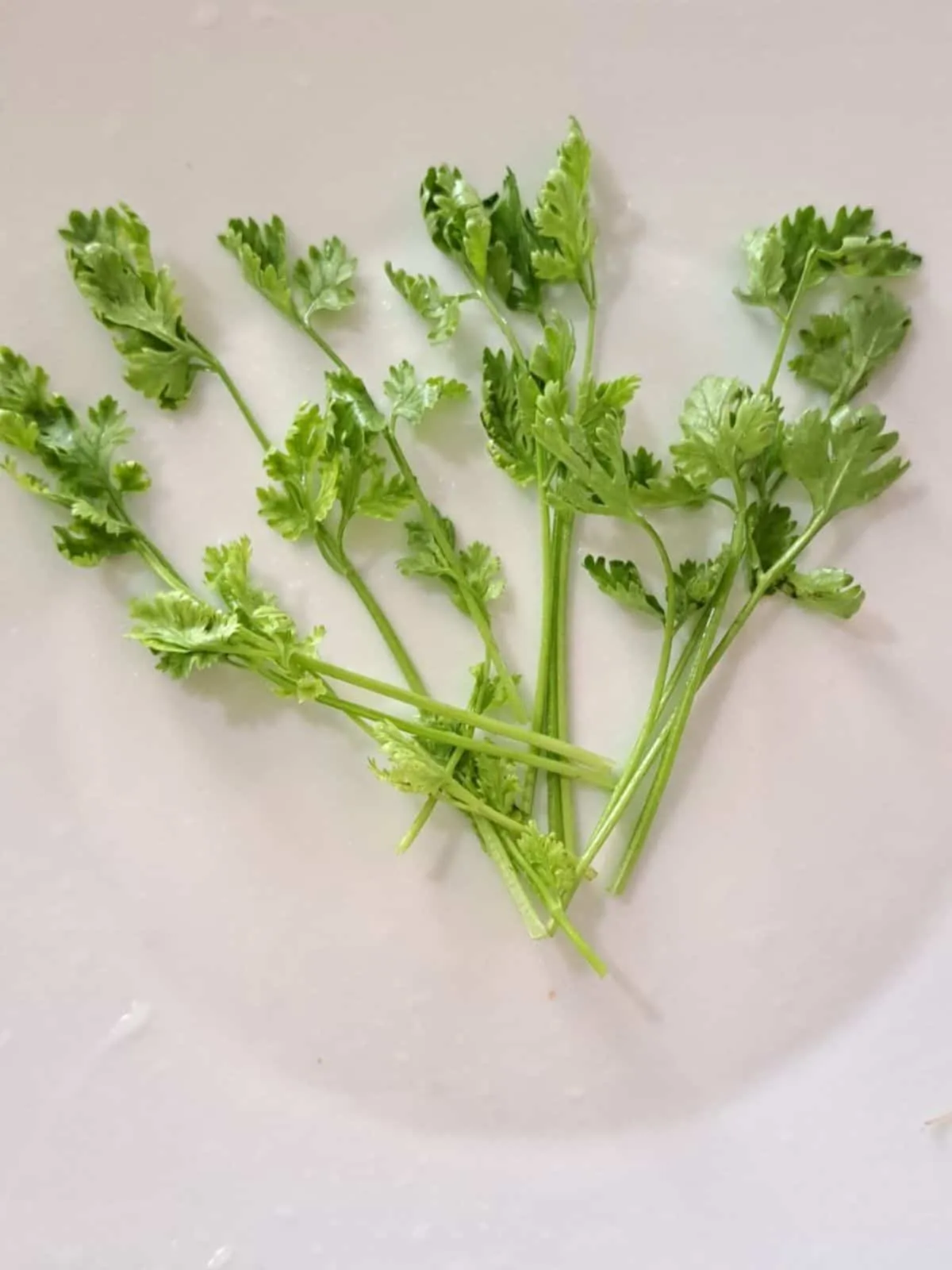
Ngò rí (or mùi ta) is right up there with green onions as one of Vietnam’s most-loved herbs.
Called cilantro in North America and coriander in many other places, it’s that final sprinkle of freshness on soups like Bun Moc, Sup Mang Cua, or even a humble pork congee.
Down South, you’ll see larger leaves and longer stems, while the Northern kind is smaller but more fragrant—the secret ingredient for the filling of Nem Rán (Northern fried spring rolls).
And don’t toss out the seeds or roots! Seeds add depth to Phở Gà (chicken Pho), while roots are the secret weapon many Hanoi vendors slip into their broth.
Thai cooking takes it even further, using both seeds and roots as the backbone of countless dishes like Gai Yang (Thai grilled chicken) and Nam Jim Jaew (Thai BBQ dipping sauce)
Cilantro shines in:
Banh Mi – that fresh, herby kick in every bite
Instant Pot Chicken Pho – with Hanoi style
3. Hẹ (Garlic Chives)

Garlic chives (hẹ) bring a punchy, garlicky kick that totally lives up to their name. You’ll spot them everywhere—tossed into quick stir-fries, floating in a light soup, or just enjoyed fresh as a bright, fragrant herb.
In Vietnam’s central region, hẹ tends to be slimmer, but they make up for with a stronger, more intense aroma.
Locals even swap them in for hành lá (green onions), using them as a garnish or whipping up a fragrant, flavor-packed chive oil.
Galic chive shines in:
Vietnamese Spring Rolls with Peanut Sauce – adding brightness and balance
Rice Paper Dumplings (Hargow inspired)
Canh Đậu Hũ Hẹ – Vietnamese tofu and garlic chive soup
4. Thì Là (Dill)

Dill (thì là) is a Northern Vietnamese favorite, though not as loved in the Central or Southern regions.
I’ll be honest — as a kid, I wasn’t a fan of its strong aroma in my mom’s Canh Cá Thì Là (dill fish soup). But growing up, I came to appreciate that bright, grassy note that makes Northern fish dishes so special.
Dill shines in:
Chả Cá Lã Vọng – turmeric fish with dill
Hanoi-style Bún Cá – fish noodle soup
Canh Cá Thì Là – classic dill fish soup
5. Ngò Gai (Culantro / Sawtooth Herb)

Ngò gai (mùi tàu), also called culantro or sawtooth herb, is instantly recognizable by its long, jagged leaves that look like tiny saw blades — hence the name.
If cilantro is a gentle whisper, ngò gai is bold and confident. It’s more aromatic, slightly peppery, and can stand up to rich, hearty dishes without being overpowering.
Flavor-wise, think of cilantro but turned up several notches. It’s bolder, more aromatic, and brings a deep, almost peppery freshness that can hold its own even in rich, hearty dishes.
Culantro shines in:
Herb plate for Phở – adds that signature kick
Bò Kho – Vietnamese beef stew, and its variations like Hu Tieu Bo Kho or Bánh Mì Bò Kho
Canh Chua – tangy-sweet sour soup
Canh Bi Do – pumpkin soup
6. Ngò Om (Rice Paddy Herb)

Ngò om (rau om / rau ngổ) adds a bright, lemony citrus note with a whisper of earthy cumin — subtle, yet unforgettable once you get to know it.
In Vietnamese cooking, ngò om and ngò gai (culantro) are like best friends, often served side by side.
Paddy herb shines in:
Herb plate for Phở – adds that signature kick
Canh Khoai Mỡ – ube soup
Canh Chua – sweet and sour soup
7. Tía Tô (Perilla Leaves)
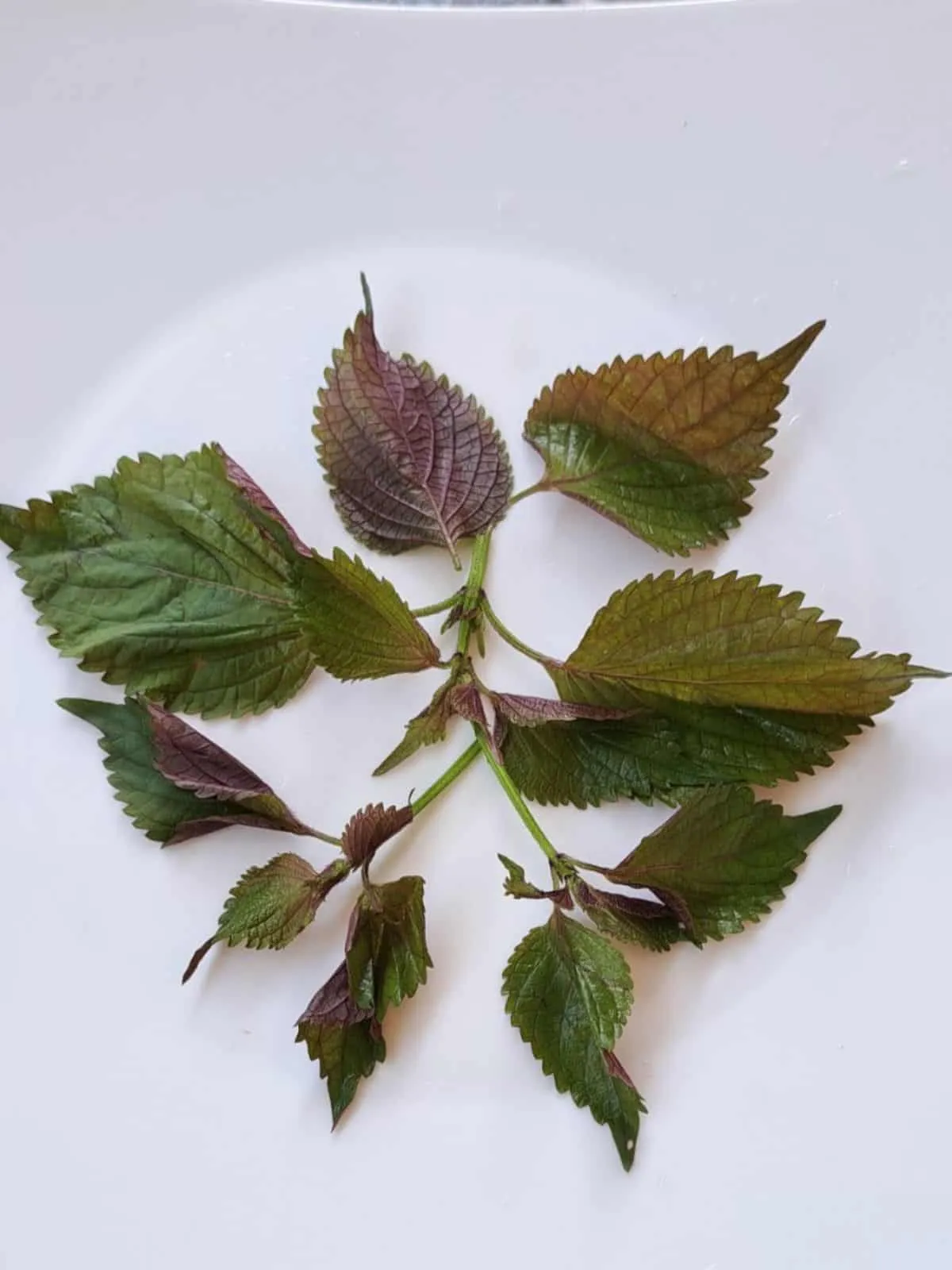
For any Vietnamese kid, a warm bowl of congee (cháo) with tía tô (perilla leaves), green onions, and a sprinkle of black pepper (tiêu) screams comfort — and doubles as a time-tested “get well soon” remedy.
But tía tô isn’t just for sick days. Its slightly minty, basil-meets-shiso flavor shines on a raw rau sống platter, especially with rich, fried dishes or hearty noodle soups like:
Canh Bun – crab noodle soup with water spinach
Bun Rieu – Vietnamese crab noodle soup
8. Kinh Giới (Vietnamese Balm / Cockscomb Mint)

Kinh giới is a Northern favorite — bold, refreshing, with a warm lemony note, a hint of mint, and just a touch of spice. It’s a must-have for many Northern iconic dishes.
Vietnamese balm shines in:
Bun Dau Mam Tom – rice noodles with fried tofu and fermented shrimp paste (a dish only the brave truly appreciate!)
Banh Cuon – silky steamed rice rolls, usually served with Cha Lua or Cha Que (cinnamon pork sausage) and a mix of fresh herbs like perilla, dill, and of course, Vietnamese balm
Bun Cha – the legendary Hanoi-style rice noodles with grilled pork and tangy fish sauce broth
9. Rau Răm (Vietnamese Coriander / Vietnamese Mint)

Rau răm, also called Vietnamese cilantro or laksa leaf, has a flavor that’s tricky to describe — herbal and grassy, with a peppery, slightly spicy kick that lingers.
In Vietnam, mention rau răm and most people immediately think of Hột Vịt Lộn (fertilized duck egg, or balut).
The pairing works beautifully thanks to Vietnamese yin-yang balance: the “cool” yin of the egg meets the “warm” yang of rau răm.
Vietnamese coriander shines in:
Central-style Goi Ga – chicken salad with a salt-and-pepper dressing instead of fish sauce dressing.
Bun Bo Hue – Hue-style beef noodle soup and its vegan version, Bun Bo Hue Chay.
Laksa – the iconic Malaysian curry noodle soup
10. Diếp Cá (Fish Mint)

Diếp cá (fish mint) is definitely one of those love-it-or-hate-it herbs—even among us Vietnamese. I have plenty of friends who still can’t warm up to its bold flavor!
It’s got a sharp, slightly sour, almost metallic taste that some people describe as “fishy.”
In Vietnam, it’s even blended into juice—yes, juice!—believed to be great for cooling the body and improving skin.
11. Húng Quế (Thai Basil)

Húng quế, or Thai basil, is one of my all-time favorite herbs. Its bold, fragrant aroma — sweet anise with just a hint of mint — instantly brightens any dish.
It’s also the key difference between Southern and Northern Phở: Southern bowls come with a generous handful of Thai basil and crunchy mung bean sprouts on the side.
Thai basil shines in:
Bo Bia – Chinese sausage spring rolls
Southern rice noodle salads – Bun Thit Nuong, Bun Bo Xao, Bun Cha Gio
Thai dishes – Pad Ped Gai (stir-fried chicken with red curry), Thai basil fried rice, Thai green curry chicken
Taiwanese Popcorn Chicken
12. Hương Nhu (Holy Basil)

Hương nhu, or holy basil, packs a sharper, more pungent punch than Thai basil, with those unmistakable licorice-like notes.
In Vietnam, you won’t see it much in everyday cooking — it’s mostly valued as a traditional remedy.
In Thailand, however, it’s a star ingredient in Pad Kra Pao (“stir-fried holy basil”). Outside Southeast Asia, it can be hard to find, but in a pinch, you can substitute Thai basil or even Italian basil.
13. Húng Lủi (Spearmint) & Húng Cây (Peppermint)


Spearmint and peppermint are close cousins — interchangeable and both bringing that cool, refreshing lift to any dish.
In Germany, they’re easy to find, making them my go-to substitutes when certain Vietnamese herbs aren’t available.
While Western cooking often keeps mint to cocktails or desserts, Vietnamese cuisine lets it shine in savory dishes.
These mints (rau húng) are a specialty of Trà Quế village near Hội An, which is why they pop up in almost every local dish.
Mint shines in:
Fresh spring rolls – chicken spring rolls, tofu spring rolls, or nem nướng rolls
Gỏi – can substitute for rau răm in Vietnamese salads (not identical, but close)
Mi Quang – Quảng-style turmeric noodle soup
Cao Lau – Hội An noodles with five-spice pork
14. Húng Chanh (Mexican Mint)

Known by many names—Mexican Mint, Indian Borage, French Thyme, Cuban Oregano, or Spanish Thyme—this versatile herb is called húng chanh or tần dày lá in Vietnam.
Its flavor sits somewhere between thyme and oregano, with a bold, slightly pungent aroma.
Beyond the kitchen, it’s a beloved folk remedy, often brewed into teas or syrups to soothe coughs and sore throats.
In cooking, húng chanh adds a fragrant twist to canh rau (vegetable soups), fresh rau sống platters, and even simple stir-fries.
15. Lá Lốt (Wild Betel Leaves / Piper Lolot Leaves)

Lá lốt are hard to miss — heart-shaped, glossy green, with deep veins giving them a slightly wrinkled look.
Their signature aroma is what sets them apart: earthy, lightly peppery, and surprisingly addictive once you’ve tried it. In Vietnamese cooking, they’re often tossed into stir-fries or used as edible wraps.
Lá lốt shines in:
Bò Nướng Lá Lốt – juicy marinated beef grilled in wild betel leaves, usually served with mắm nêm (fermented anchovy sauce)
Chả Lá Lốt – ground pork wrapped in the leaves and fried, a beloved casual dish in Northern Vietnam
16. Lá Nếp / Lá Dứa (Pandan)
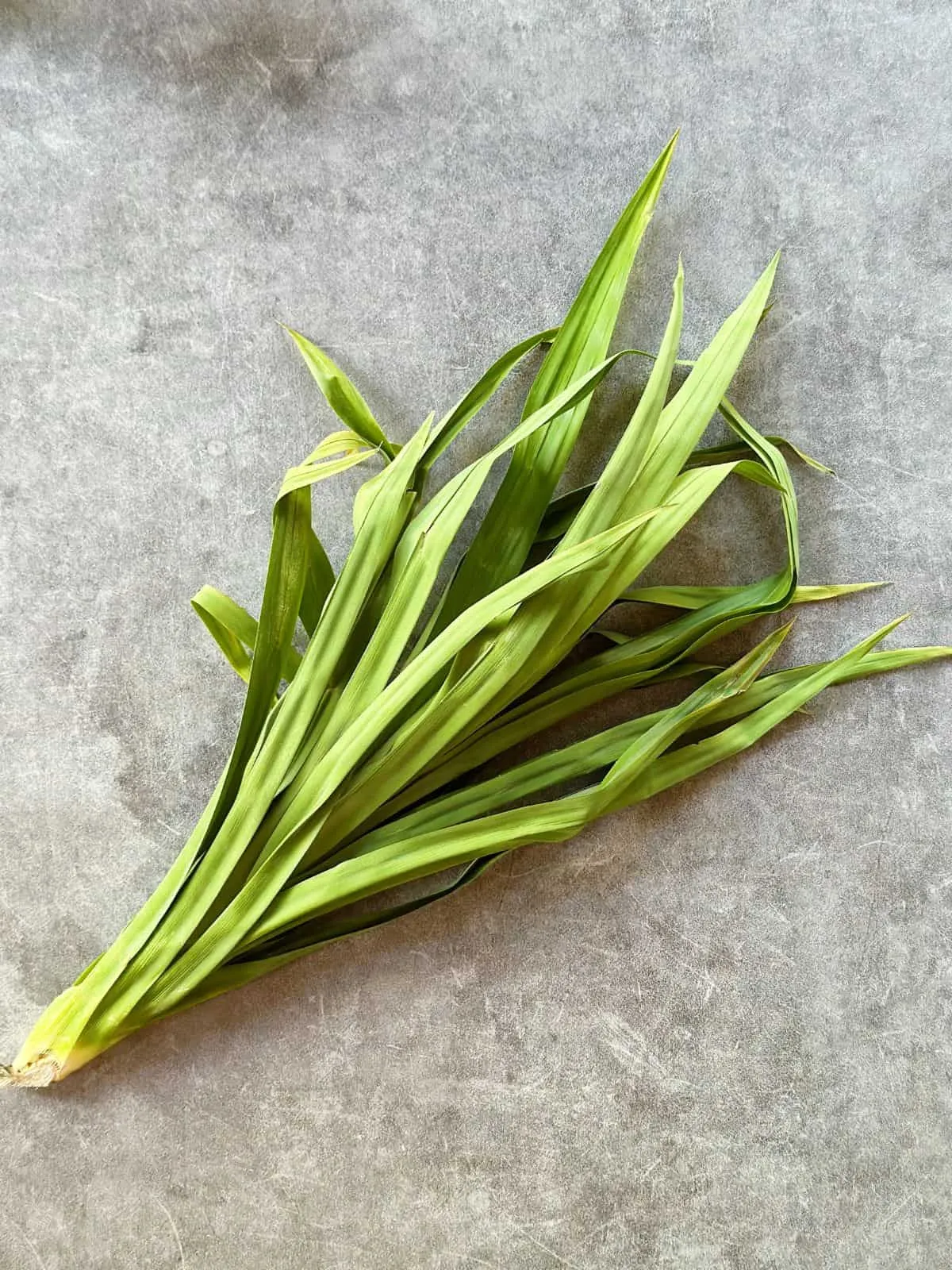
Pandan is often called Southeast Asia’s vanilla — cherished across Vietnam and beyond. Its flavor is fresh and grassy, with sweet hints of coconut, vanilla, and a subtle nutty note reminiscent of almond or hazelnut.
In Vietnam, pandan isn’t just for sweets. It flavors Com Ga Hai Nam (Vietnamese Hainan chicken rice) and even helps soften the richness in Beef Phở broth.
For desserts, Vietnamese aunties love using pandan — from naturally coloring cakes to tossing in leaves for that unmistakable fragrance.
Pandan is also trending in Asian-inspired desserts, often paired with ube, matcha, or Vietnamese coffee.
Pandan shines in:
Traditional Vietnamese cakes: Banh Da Lon, Banh Bo Nuong, Banh Bo Hap
Southeast Asian & fusion treats: pandan chiffon, pandan bread, pandan waffles
Chè (Vietnamese dessert soups): Che Khuc Bach, Che Thai, Banh Lot and more
Sticky rice: a few pandan leaves add both color and fragrance to Xoi La Dua or Xoi Dau Xanh
17. Rau Khúc (Cudweeds)

Rau khúc (cudweeds) might be a humble plant, but in Vietnam, it’s the star ingredient in Xôi Khúc—that cozy, fragrant sticky rice stuffed with mung beans and pork, wrapped in a green dough made from these wild leaves.
Fresh rau khúc can be hard to find outside Vietnam. You might spot it in powdered form at some Asian stores, or you can improvise with kale, kohlrabi leaves, or spinach. It’s not exactly the same, but it still gives you that comforting, herby vibe.
18. Rau Đắng (Common Knotgrass)

Rau đắng literally means “bitter leaves” in Vietnamese—and yep, the name doesn’t lie. It has a mildly bitter, clean taste that pairs beautifully with rich or hearty dishes.
You’ll often find it in Cháo Cá Rau Đắng (fish congee with bitter herbs) or served fresh with hot pot, where it helps balance out the fatty broth.
19. Ngải Cứu (Mugwort)

Ngải cứu might be famous in Korean cooking, but it’s just as cherished in Northern Vietnam. Its warm, slightly spicy, and gently bitter flavor adds depth to even the simplest dishes.
Mugwort shines in:
Trứng Rán Ngải Cứu – Vietnamese omelette with mugwort
Gà Hầm Ngải Cứu – slow-cooked chicken with mugwort
20. Sả (Lemongrass)

Lemongrass (sả) is one of the unsung heroes of Vietnamese and Southeast Asian cooking. Its bright, citrusy aroma and subtle gingery warmth can bring a dish to life with just a few bruised stalks.
Beyond flavor, lemongrass helps mellow stronger, funkier ingredients — yes, even mắm!
You’ll find it everywhere in Vietnamese cuisine: in soups, stews, marinades for grilled meats, and stir-fries that need a lively, zesty kick.
Lemongrass shines in:
Ga Xao Sa Ot – spicy lemongrass chicken
Vietnamese Lemongrass Chicken (grilled)
Vietnamese Pork Chops (grilled)
Thit Nuong – grilled pork skewer
Bun Mam – fermented fish noodle soup from Mekong Delta region
Ca Ri Ga – Vietnamese chicken curry
21. Tỏi (Garlic)

Garlic (tỏi) may look humble, but in Vietnamese kitchens it’s a real powerhouse.
We favor the smaller, sharper cloves—the legendary ones from Lý Sơn Island in Quảng Ngãi are especially prized. Tiny as they are, they deliver a deep, punchy flavor that can transform a dish in seconds.
You’ll almost always find a bit of raw garlic mingling in Nuoc Cham (Vietnamese dipping fish sauce).
Beyond that, it’s everywhere—tossed in stir-fries, rubbed into marinades, stewing in braises, sizzling in the wok, or crisped up as a garnish.
Fried garlic and garlic oil are like liquid gold—just a spoonful elevates noodle soups like Hủ Tiếu Nam Vang and Hủ Tiếu Mỹ Tho.
Garlic shines in:
Coconut Chicken (Vietnamese-style)
Thit Kho Tieu – Peppery braised pork
Thit Kho Trung – Southern-style braised pork & eggs
Stir-fried Water Spinach with Garlic
22. Hành Tím (Shallots)
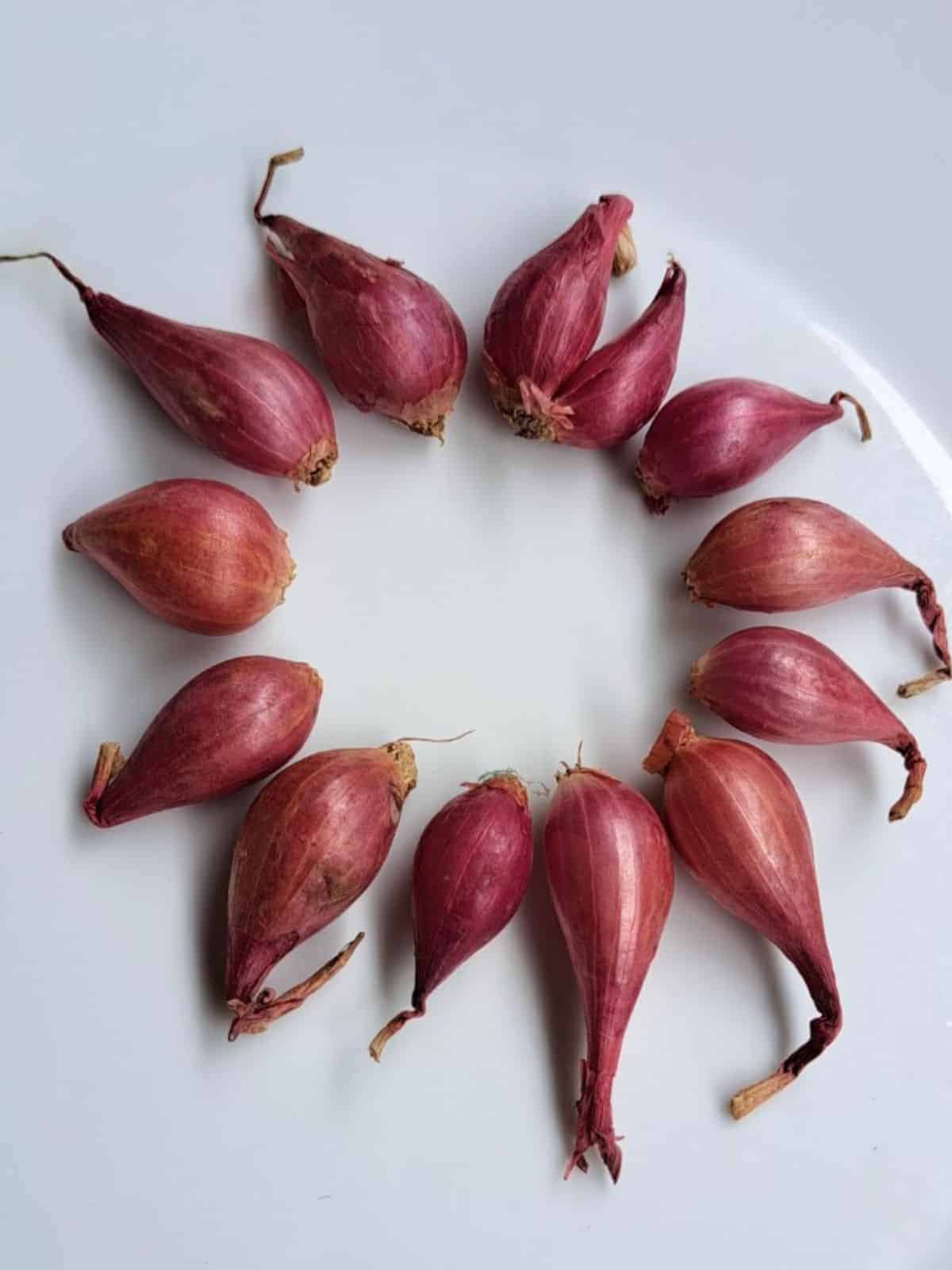
In Vietnamese kitchens, hành tím (shallots) and tỏi (garlic) are inseparable—like old friends who just get each other. Their flavors balance so naturally that, if needed, you can even let one stand in for the other.
Hành phi (crispy fried shallots) are little flavor bombs—adding crunch, aroma, and that addictive savory note.
They’re a must on Xoi Xeo (Hanoi mung bean sticky rice), a tasty upgrade for Pho Tron (dry chicken pho), and the secret weapon that makes our rice paper salad so irresistible.
Shallots shine in:
Thit Kho (Northern-style) – Braised Pork & Eggs with that deep, glossy Vietnamese caramel sauce.
Suon Ram Man – Sticky, savory caramelized pork ribs
Sweet and Sour Pork Ribs (Vietnamese-style)
Mam Chung – Steamed egg meatloaf with salted fish
Ca Kho – Caramelized catfish
23. Tỏi Tây / Hành Boaro (Leeks)

In Vietnam, leeks (tỏi tây) often play the understudy for garlic, green onions, or shallots—especially in vegan and vegetarian cooking.
They’re a favorite among Buddhists who skip strong aromatics but still want that comforting layer of flavor in their dishes.
24. Củ Nén / Hành Tăm (Vietnamese Pearl Onion)

Củ nén is a beloved herb from Quảng Nam and Đà Nẵng, with a flavor that falls somewhere between shallots, garlic, and garlic chives—less sharp but deeply aromatic.
In Vietnam, a bowl of Mì Quảng just isn’t the same without its gentle fragrance. Since I live abroad, I usually make do with pearl onions or shallots to mimic that unique taste.
25. Gừng (Ginger)

Ginger (gừng) is one of those must-have staples in a Vietnamese kitchen—right up there with garlic, green onions, and shallots.
It’s our go-to for cutting through the strong smell of meat and seafood, while leaving behind that comforting, peppery warmth.
And it’s not just for savory dishes. Ginger finds its way into sweets and drinks too—like Mứt Gừng (candied ginger) for Lunar New Year or a steaming cup of Trà Gừng (ginger tea) on a rainy afternoon.
Ginger shines in:
Kimchi Duruchigi – Spicy Pork Stir-fry with Kimchi
Steamed Whole Fish with Ginger
Stir-fried Pork with Ginger
26. Nghệ (Turmeric)

In Vietnam, nghệ (turmeric) isn’t just a kitchen spice—it doubles as a trusted folk remedy and quietly slips into our daily cooking (though, honestly, that’s how we treat most herbs and spices).
You’ll even see it brighten up simple boiled chicken dishes across the country.
Turmeric shines in:
Bánh Xèo – Vietnamese sizzling pancakes
Bánh Khọt – mini crispy pancakes
Bánh Tôm Chiên Khoai Lang – sweet potato & shrimp fritters
Chuối Chiên – banana fritters
Cơm Gà Hội An – the famous Hội An chicken rice
Cơm Gà Nha Trang – Nha Trang’s take on chicken rice
27. Riềng (Galangal)

Galangal (riềng) might be the darling of Thai kitchens, but here in Vietnam, it often stands in the shadow of its cousin, ginger.
That said—head up North, and you’ll find riềng stepping into the spotlight, bringing its bold, peppery warmth to some of the most traditional and soulful dishes.
Galangal shines in:
Many Thai dishes – Tom Yum, Tom Kha Gai (its Thai claim to fame)
Chân Giò Nấu Giả Cầy – braised pork knuckles simmered with galangal and fermented shrimp paste, a true Red River Delta classic.
28. Ớt (Chili)

When it comes to chilies (ớt), nowhere in Vietnam celebrates them like Central Vietnam—especially Huế, where heat is part of the identity.
We use all kinds of chilies in our cooking—Thai bird’s eye for that instant fiery kick, goat’s horn for their bold red that makes dishes pop, and Thai green chilies for their unique aroma and fresh color.

Chili shines in:
Sa Te – Vietnamese Lemongrass Chili Oil
Pho Sa Te – Spicy Beef Satay Pho
Chili Oil Eggs – 5 minutes to fiery goodness
Vietnamese Green Chili Sauce – the perfect dip for seafood
29. Lá Chanh (Lime Leaves)

Lime leaves (lá chanh) are the secret spark in Northern Vietnamese chicken dishes—their citrusy fragrance is simply unbeatable.
Lime leaves shine in:
Phở Gà – Chicken Phở
Gà Kho – Caramelized Chicken
Gà Luộc – Vietnamese Boiled Chicken
Muối Tiêu Chanh – the classic lime-pepper salt dip
30. Lá Chúc (Kaffir / Makrut Lime Leaves)

In Vietnam, lá chúc (makrut lime leaves) are a rare find compared to regular lime leaves.
They mostly grow in An Giang, near the Cambodian border, where locals use them as a fragrant stand-in for lime leaves in their cooking.
Dive Deeper into Vietnam’s Rich Food Culture
Vietnamese Vegetables: A Simple Guide to Using Them in Your Cooking
Vietnamese Fruits: Must-Try Picks and How Locals Enjoy Them
Vietnamese Coffee Brands: Top Picks to Try When You Visit Vietnam
Vietnamese Chocolate: The Delicious Hidden Gem You Should Know
Northern Pho vs. Southern Pho: Understanding Vietnam’s Regional Twist on the Classic Soup
Save or pin this fantastic guide so you always know where to find it.
If you have any questions about Vietnamese herbs, whether it’s identifying them or understanding how to use them, feel free to ask—I’m more than happy to help you :).
And don’t forget to stay in touch with me on Instagram, Facebook, Pinterest, and YouTube 🥰.
